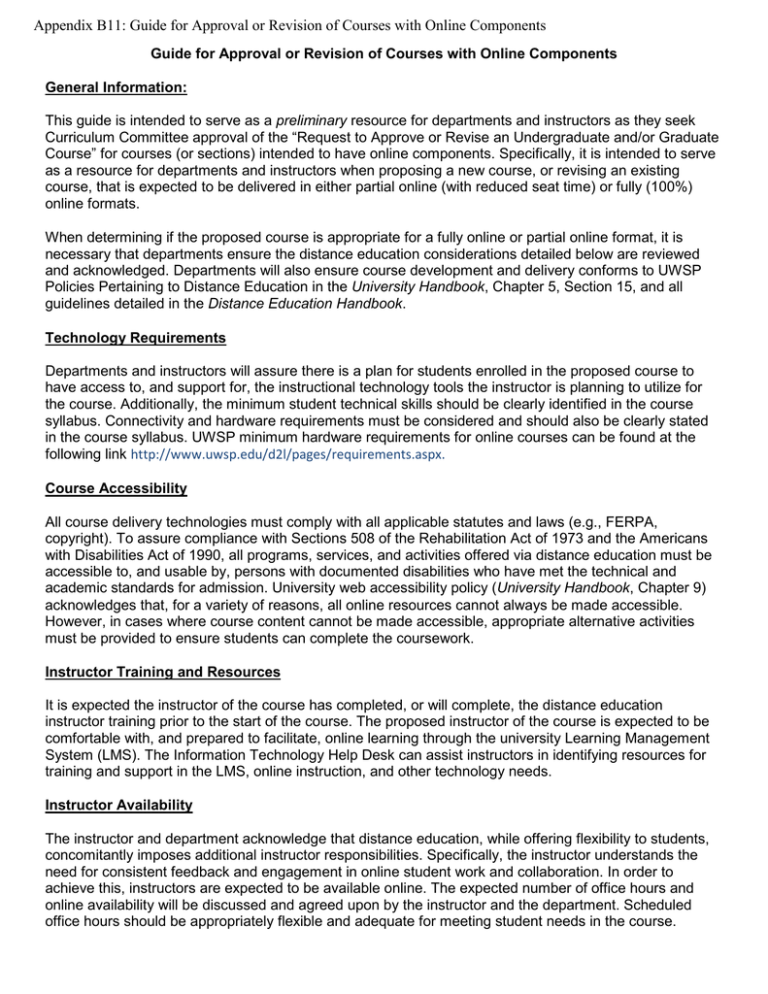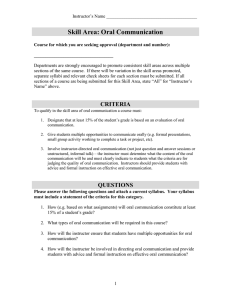Appendix B11: Guide for Approval or Revision of Courses with...
advertisement

Appendix B11: Guide for Approval or Revision of Courses with Online Components Guide for Approval or Revision of Courses with Online Components General Information: This guide is intended to serve as a preliminary resource for departments and instructors as they seek Curriculum Committee approval of the “Request to Approve or Revise an Undergraduate and/or Graduate Course” for courses (or sections) intended to have online components. Specifically, it is intended to serve as a resource for departments and instructors when proposing a new course, or revising an existing course, that is expected to be delivered in either partial online (with reduced seat time) or fully (100%) online formats. When determining if the proposed course is appropriate for a fully online or partial online format, it is necessary that departments ensure the distance education considerations detailed below are reviewed and acknowledged. Departments will also ensure course development and delivery conforms to UWSP Policies Pertaining to Distance Education in the University Handbook, Chapter 5, Section 15, and all guidelines detailed in the Distance Education Handbook. Technology Requirements Departments and instructors will assure there is a plan for students enrolled in the proposed course to have access to, and support for, the instructional technology tools the instructor is planning to utilize for the course. Additionally, the minimum student technical skills should be clearly identified in the course syllabus. Connectivity and hardware requirements must be considered and should also be clearly stated in the course syllabus. UWSP minimum hardware requirements for online courses can be found at the following link http://www.uwsp.edu/d2l/pages/requirements.aspx. Course Accessibility All course delivery technologies must comply with all applicable statutes and laws (e.g., FERPA, copyright). To assure compliance with Sections 508 of the Rehabilitation Act of 1973 and the Americans with Disabilities Act of 1990, all programs, services, and activities offered via distance education must be accessible to, and usable by, persons with documented disabilities who have met the technical and academic standards for admission. University web accessibility policy (University Handbook, Chapter 9) acknowledges that, for a variety of reasons, all online resources cannot always be made accessible. However, in cases where course content cannot be made accessible, appropriate alternative activities must be provided to ensure students can complete the coursework. Instructor Training and Resources It is expected the instructor of the course has completed, or will complete, the distance education instructor training prior to the start of the course. The proposed instructor of the course is expected to be comfortable with, and prepared to facilitate, online learning through the university Learning Management System (LMS). The Information Technology Help Desk can assist instructors in identifying resources for training and support in the LMS, online instruction, and other technology needs. Instructor Availability The instructor and department acknowledge that distance education, while offering flexibility to students, concomitantly imposes additional instructor responsibilities. Specifically, the instructor understands the need for consistent feedback and engagement in online student work and collaboration. In order to achieve this, instructors are expected to be available online. The expected number of office hours and online availability will be discussed and agreed upon by the instructor and the department. Scheduled office hours should be appropriately flexible and adequate for meeting student needs in the course. Course Learning Outcomes Prior to the start of the course, course learning outcomes should be established for the proposed course according to the policies and norms established by the department. Learning outcomes for online courses should be the same as those for face-to-face courses. Each proposed course learning outcome should have the method(s) of assessment identified. Course Content Delivery Utilization of a variety of instructional methods allows faculty to meet varied student learning styles. During course development, it is highly recommended that the course instructor consult with campus instructional technologists to examine the variety of instructional technologies UWSP supports. To promote student and instructor interaction, the instructor should outline a variety of instructional strategies appropriate for online courses. These should be selected based on their ability to engage learners in meeting the course learning outcomes. These can include, but are not limited to: • • • Collaborative content creation tools Discussion boards (asynchronous) and Chatrooms (synchronous) Lecture capture Student Assessment In developing the course syllabus instructors should consider that most methods for assessing student performance and meeting learning outcomes in a face to face setting can also be administered in an online setting. Traditional tests can be administered through the LMS or via proctored exams. Examples of additional evaluation techniques include, but are not limited to: • • • • • • • • • • • • Research papers Blogging Case study discussion/writing Collaborative writing projects Electronic portfolios (e-portfolios) Peer evaluation Project (group and Individual) Reflective journaling Student-created podcasts or other multimedia Student-led discussions Student presentations (recorded) Essays Course Evaluation The department and instructor acknowledge that all distance education courses and programs will be assessed and evaluated according to the course evaluation procedures in effect for on-campus courses. Additional departmental course evaluation criteria and procedures established for on-campus courses may be modified and implemented for distance education courses. Student evaluations in fully online, partially online, and Continuing Education courses will be conducted regularly and may be considered in personnel decisions, instructional improvement, and recognition, as outlined in the University Handbook (Chapter 4A, Section 2 and Chapter 4B, Section 3). The Student Evaluation of Online Course Instruction Form and supporting information is located in the University Handbook (Chapter 4D, Section 15).


